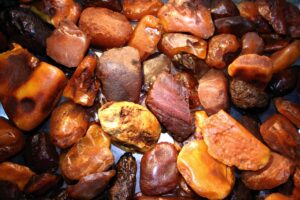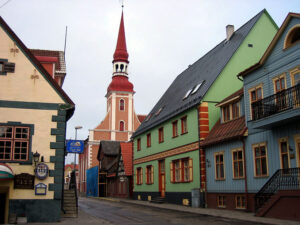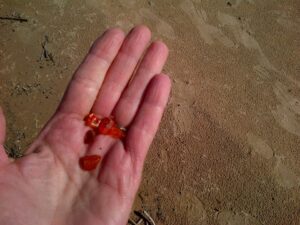
It really was there: tear-shaped chips of amber in the flotsam left by the lapping of the waves. We had stopped at Pärnu to drool over the beauty of the Baltic Coastline and look for amber. We scrambled out of the bus like kids, some of us pulling off our socks and shoes, and others not caring what got wet or sandy.
The legend of Baltic Amber tells of about a sea goddess whose palace was made of pure amber. The palace broke up, but centuries later one still finds its fragments washed up along the beaches in this part of the world. Yes, that’s where those gorgeous amber rings, pendants, and necklaces come from—the Baltic Sea.
My chips were kind of tiny, and they wouldn’t make very good jewelry. But they came straight from the sea! I’m usually not very good at finding things. In fact, I barely see things. (If you know me, you realize that’s true.)
Yet, in the glittering sun, with crystal light from the far-northern skies filtering down, even the tiniest piece of amber sparkled. And I saw them . . . five pieces, to be exact. Into my pocket they went, to “take home” with me.
Isn’t that what learning is? Chips of something valuable that we look for and hope to find. Whether we are journeying to find our knowledge, or sitting in a library or at home, searching through complex texts or plowing through secondary resources, isn’t that we’re trying to do? Find fragments of learning, of amber? Scooping them up and putting them in the pockets of our minds?

Surreal Name Given (CC BY 2.0)
Sometimes we find enough fragments to make a whole idea. Other times we discover one tiny chip that fills in a gap. With that chip, we can animate a long line of ideas. On this particular trip for Smithsonian Journeys, one of the chips I’ve been helping my group members find has to do with the complex story of the Baltic States. What is each nation’s identity? How has it come about? Big questions about a small, but critically important region.
There’s Lithuania whose cultural and historical identity became linked in the Renaissance with the powerful kingdom of Poland. In the case of Latvia and Estonia, the identities are quite different. Here we have to search for chips of amber to illuminate everything from the geographical realities of “the Duchy of Courland” and the chronology of the Livonian knights to the dark story of German and Russian occupation.
Then you can throw in the three countries’ complex religious histories and linguistic identities. One of the languages (Estonian) lies outside the Indo-European fold entirely, related only to Finnish and Hungarian. Latvian and Lithuanian have only partial overlap, and that doesn’t count the many dialects in each nation. That gives you a pretty wide beach to comb.
Sounds as if it’s too much to grasp, doesn’t it? But sometimes all one needs is a few hooks—a few pieces of amber—to hold on to. Perhaps it’ll be a medieval knight who keeps popping up in monuments, stained-glass windows, and in our guides’ narrations. Or maybe it’s the architecture of the Blackfriars houses (single-men’s guild houses) on the squares in Riga and Tallinn. What about the powerful, shared tradition of the Singing Festivals (The Singing Revolution) where the irrepressible energy of folk songs has sustained Estonia, Latvia, and Lithuania through centuries of devastation and repression, particularly that wreaked by the Soviets!
 Amber appears weighty, but it’s surprisingly light. It feels more like foam in one’s hand than a pebble. Hard to find, but light to bear. That perhaps is another way to look at learning, especially when we look back on our own years of study. We can see what our children cannot: the effort to find, gain, and pocket knowledge is not easy. But having knowledge is a light and airy thing.
Amber appears weighty, but it’s surprisingly light. It feels more like foam in one’s hand than a pebble. Hard to find, but light to bear. That perhaps is another way to look at learning, especially when we look back on our own years of study. We can see what our children cannot: the effort to find, gain, and pocket knowledge is not easy. But having knowledge is a light and airy thing.
Knowledge lightens our hearts and our souls. It eases and inspires our minds. It fuels the great God-given capacity we have to learn in the abstract and to apply our learning to the concrete.
So, stop the bus from time to time. Pull off your shoes, especially as the summer has come and more structured learning can take a back seat to spontaneous discovery. Run on the beach and let the sunlight guide your eye to those chips of learning that are the unexpected jewels. Gaze in delight at them, and put them in a secure pocket. Their light will warm our souls and light the way through the dark days of winter.



